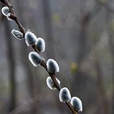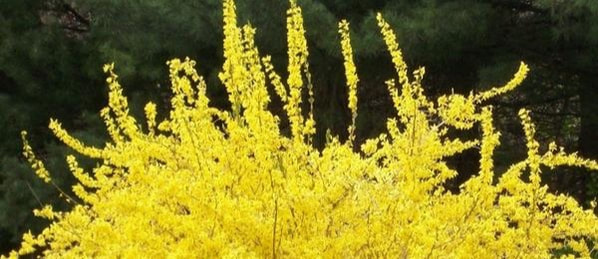
Weather
It’s about 10 degrees warmer on average than it was last month. February temperatures are in the high 20’s at night to mid-50’s during the day. Actual temperature variations may be extreme this month. There’s almost as much snow as in January, and it’s mostly sunny. Gardening activities accelerate this month. As day time temperatures warm up it feels like spring is just around the corner. Unfortunately, February is just a tease and belies the March-through-May winds that invariably come later. Take advantage of this brief respite to prepare your garden for spring planting. What’s Blooming Crocus, snowdrops (Galanthus), pussy willow, Iris reticulata, Mahonia, and winter jasmine (J. nudiflorum) begin blooming this month. In south-facing beds, you will see daffodils beginning to open and the earliest forsythia. Apricot trees begin blooming later in the month. Xeric Blooms Prostrate rosemary (Rosmarinus o cinalis “prostrate”) is covered with tiny blue flowers if it is in a protected sunny spot. Tiny tulips, daffodils, and Crocus — species bulbs, not their giant cousins— make a colorful display now through March. Garden Activities Observe what is happening in your garden on warm days. Pay attention to protected areas of the yard. Is there an enclosed patio or south-facing area of your yard that enjoys milder temperatures? Could you grow more tender, Zone 8 or 9 plants here, or get earlier blooms from spring bulbs? Check under leaf piles for hidden signs of spring – new growth, an undetected bloom. Cut a few branches of Forsythia and other early- flowering shrubs to bring indoors. Put them in a vase of water and they will soon flower for you. Many plants begin to show some signs of activity this month. If you go looking, you’ll find some early swelling buds on trees and shrubs, and new green growth pushing up from roots and bulbs. Your children will enjoy this activity; they can be taught to keep looking for first signs of spring and to follow the development of plants growing around them. Go by the Albuquerque Garden Center and check out the courtyard to see a warm microclimate and early blooming plants. While you’re there, take a look in the library, do a little research or catalog browsing, and look at the many garden books in the gift shop. To Do List
Increase watering to 2 or 3 times a month as temperatures go above 50 degrees. Be sure to water irises from now until they finish blooming. Pruning Continue pruning. Some shrubs need to be pruned hard: Butterfly bush, Russian sage, and ornamental grasses (except blue fescue) need to be pruned almost to the ground. Many shrubs should not be pruned at this me. If you know the names of your plants, you can find out what sort of pruning each requires. Pruning references include: The Master Gardener Hotline, Sunset Western Garden Book, or Enchanted Gardening. Consult the “Information Sources” section in this book. Some shrubs must be pruned immediately after blooming in order to not cut off the next year’s blooms. Planting
Troubleshooting Pests & Problems. Look for early aphids on pine trees. Scale on Euonymus is a widespread problem. When the new hatchlings, called “crawlers,” emerge, they are most susceptible to control. In warm spots, this can be as early as February. The crawlers appear as tiny yellowish dust moving about. Early treatment of pests and problems keeps them from becoming big problems. Both of the above conditions have a non-poisonous treatment: Horticultural oil spray for scale and a strong blast of water for aphids. Conversely, knowing that euonymus is subject to scale, consider replacing these plants with better suited alternatives. Crown Gall. As you transplant roses or other dormant plants, look for unusual swellings along the stems which may indicate crown gall. If found, either cut away the stem or remove the plant and choose not to plant that plant again. There is no treatment for the bacterial infection which causes crown gall – prevention is the best alternative. Prevention can be done by avoiding wounding susceptible plants at or near the soil line and sterilizing your pruning tools between cuts using rubbing alcohol in a closed spray bottle. Plant identification. Are you not sure what plants you have in your yard? Take the time now to begin identifying them with the help of plant books and information from other gardeners. If there are plants you can’t identify, take a sample and/or a photo to the Garden Center or the County Extension Office. Master Gardeners or the county extension agent can help, sometimes with a home visit. You may have to wait for some plants to leaf out before taking a sample. Once you learn what you have, become an expert on that plant. Spring weeds. If you had a lot of annual weeds last year, now is the time to solarize your soil to eliminate them this year. Do not solarize the soil where you planted bulbs and perennials, as the heat build-up may harm them. Solarization will also help eliminate nematodes and other harmful organisms. (See “Soil Solarization for Weed Control” in the Garden Talk Section of this book.) Start monitoring for Piñon needle scale during mild winters (see March checklist). The egg masses appear as whitish cottony material in bark crevices on the trunk and major branches. Hose this material off with a strong jet of water to eliminate most of the eggs. Use a stiff brush or broom to help remove the eggs. If removed in this way, most will not hatch and those that survive will hatch far from their host. You may want to leave a few to monitor for hatching – when rubbed into the palm of your hand, unhatched eggs leave a yellow smear. Weekly Check Walk - Continue your weekly check walk. Take care of any broken branches and obvious insect infestations. Watch out for signs of disease. Check soil moisture. Make notes about plants to move to a new location, new plants you’d like to try, and something to fill up that obvious gap that you just noticed. Houseplants Celebrate Valentine’s Day! Buy flowering house plants or pansies for your Valentines and take one home for yourself. Spending time in a greenhouse is a time-tested cure for the midwinter blues. If you re-pot your purchases, you can get your hands dirty, too! This is an excerpt from the calendar published by the Albuquerque Master Gardeners. www.abqmastergardeners.org Visit their website for a schedule of classes and events!
0 Comments
|
Archives
March 2018
Categories |


 RSS Feed
RSS Feed